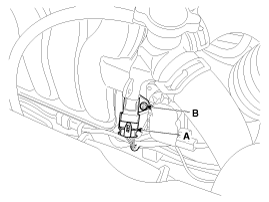Kia Cee'd: Engine Control System / Intake Air Temperature Sensor (IATS) Repair procedures
| 1. |
Turn the ignition switch OFF.
|
| 2. |
Disconnect the IATS connector.
|
| 3. |
Measure resistance between the IATS terminals 3 and 4.
|
| 4. |
Check that the resistance is within the specification.
|
Specification: Refer to “Specification”
|
|
| 1. |
Turn the ignition switch OFF and disconnect the battery negative (-)
cable.
|
| 2. |
Disconnect the manifold absolute pressure sensor connector (A).
|
| 3. |
Remove the installation bolt (B), and then remove the sensor from the
surge tank.

|
| • |
Install the component with the specified torques.
|
| • |
Note that internal damage may occur when the component is dropped.
If the component has been dropped, inspect before installing.
|
|
| • |
Insert the sensor in the installation hole and be careful not
to damage.
|
|
| 1. |
Installation is reverse of removal.
|
Intake air temperature sensor (IATS) installation bolt:
9.8 ~ 11.8 N.m (1.0 ~ 1.2 kgf.m, 7.2 ~ 8.7 lb-ft)
|
|
Description
Engine Coolant Temperature Sensor (ECTS) is located in the engine coolant passage
of the cylinder head for detecting the engine coolant temperature. The ECTS
uses a t ...
Other information:
Kia Cee'd JD Owners Manual: If you do decide to pull a trailer
Here are some important points if you decide to pull a trailer:
Consider using a sway control.You can ask a hitch dealer about sway
control.
Do not do any towing with your car during its first 2,000 km (1,200
miles) in order to allow the engine to properly break in. Failure
to heed th ...
Kia Cee'd JD Owners Manual: Speedometer
■ Type A
■ Type B • km/h
■ Type B • MPH
■ Type C • km/h
■ Type C • MPH
The speedometer indicates the vehicle
speed.
The speedometer is calibrated in kilometers
per hour and/or miles per hour. ...
 Intake Air Temperature Sensor (IATS) Schematic diagrams
Intake Air Temperature Sensor (IATS) Schematic diagrams Engine Coolant Temperature Sensor (ECTS) Description and operation
Engine Coolant Temperature Sensor (ECTS) Description and operation


